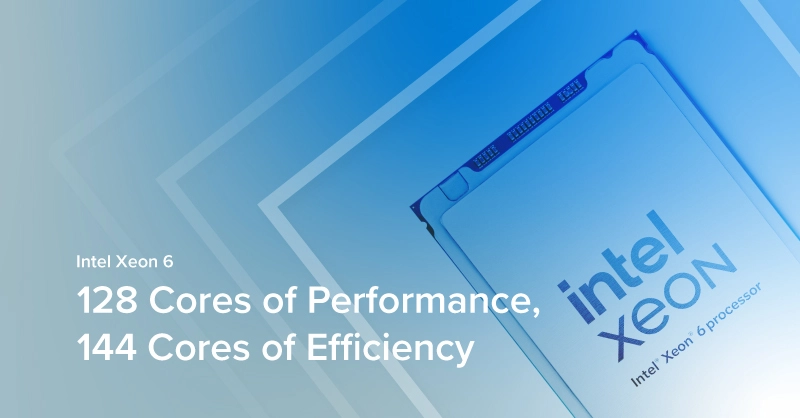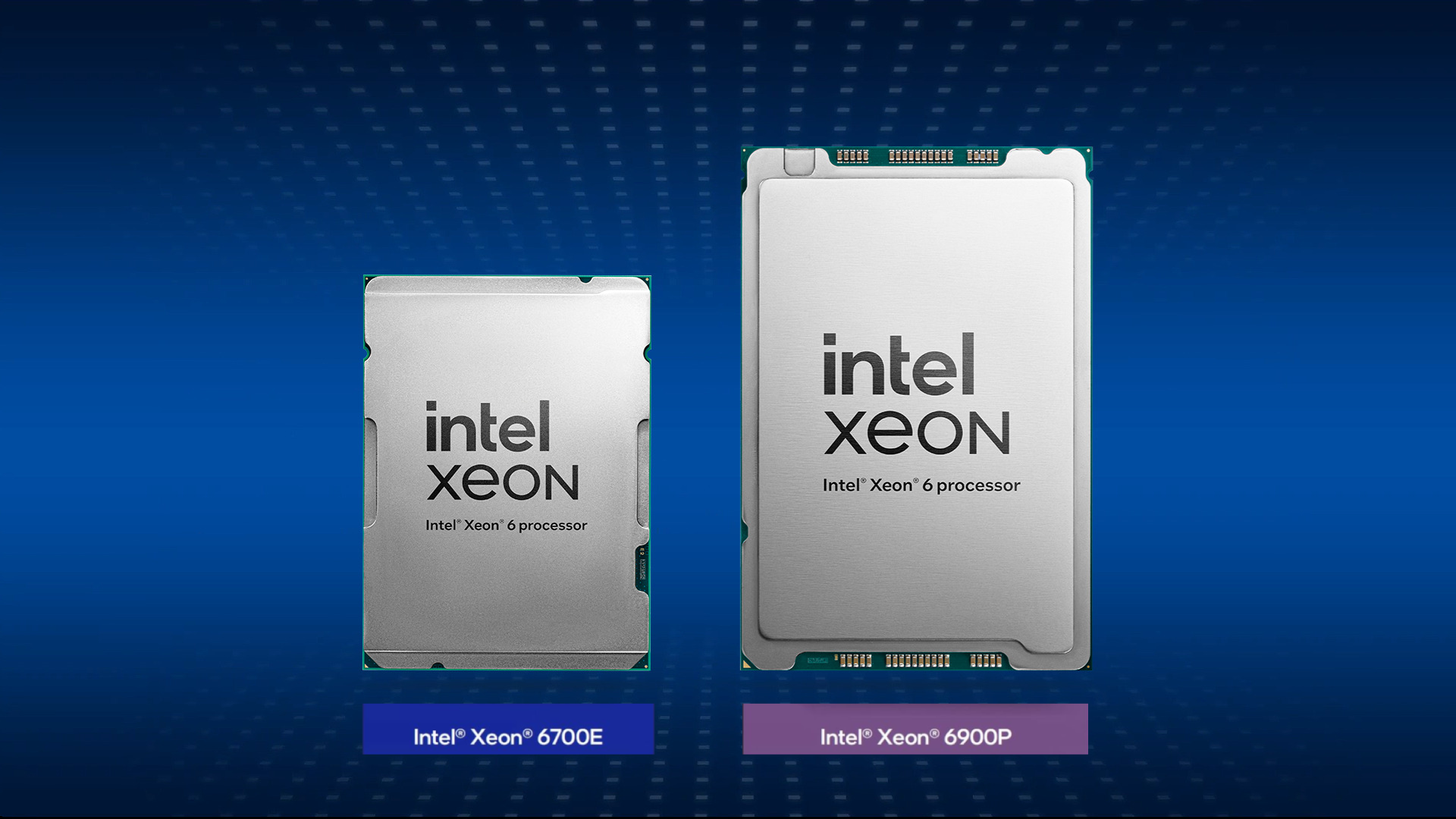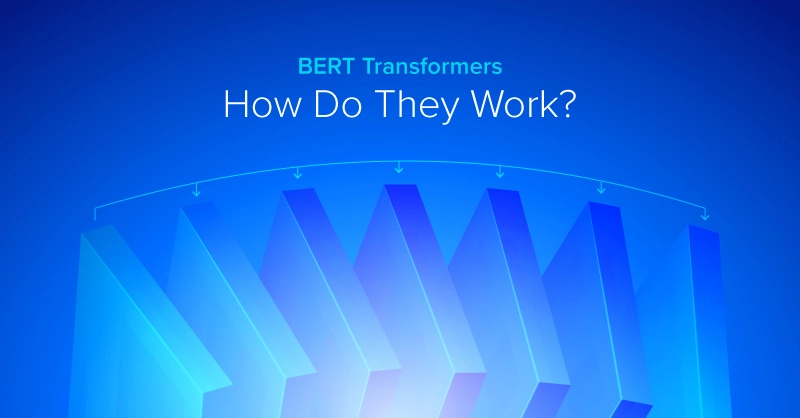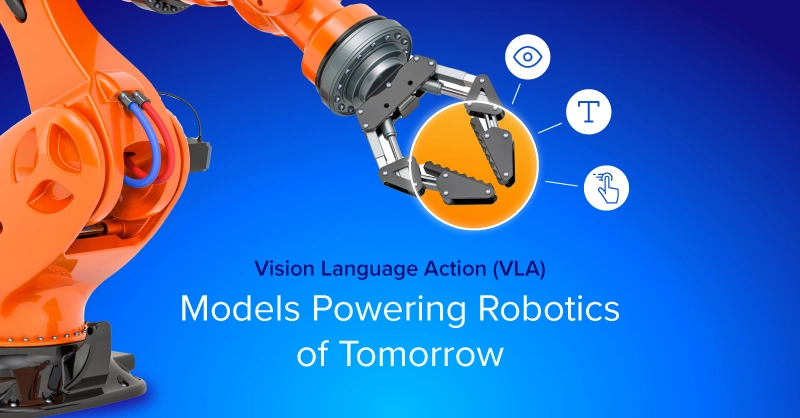
Introduction
When evaluating a data center's effectiveness, there are two main metrics: high performance and performance per watt. The high performance focuses on achieving maximum computational power, which is essential for demanding workloads that require rapid processing. On the other hand, performance per watt emphasizes energy efficiency, which is crucial for reducing operational costs or staying within environmental constraints. That is Intel’s approach for their next generation of enterprise server processors.
Intel Xeon 6 is the upcoming generation of Intel server processors. It will feature P-core-only SKUs and introduce an all-new E-core-only line of Xeon processors.

Intel Xeon 6 - What are P-cores & E-cores
The distinction between Intel’s P-cores (Performance cores) and E-cores (Efficient cores) addresses different computing needs, optimizing processors for a variety of tasks and power efficiency levels. Intel’s Core series lineup has a mixture of P-cores and E-cores to distribute and handle various tasks. For example, the 14900K has 8P & 16E cores.
P-cores, or Performance cores, are larger cores optimized for performance featuring high clock speeds, increased IPC (instructions per clock), and hyper-threading capabilities. P-cores are ideal for demanding processes and applications that benefit from instructions per clock processing such as rendering, AI training, simulation, and more.
In contrast, E-cores, or Efficient cores, are optimized for energy efficiency and are better suited for handling tasks that require less power. These cores are smaller, consume significantly less power compared to P-cores, and do not support Hyper-Threading. The primary advantage of E-cores is their ability to enhance the overall energy efficiency of the processor, handling background tasks, and lightweight application services while reserving the stronger P-cores to do the heavy lifting.
This hybrid core approach allows Intel’s CPUs to balance high performance with energy efficiency, providing a versatile platform that can adapt to a range of workloads by dynamically shifting between core types based on task requirements. However, dedicated processors exclusively P-core or E-core can bring hybrid flexibility to the data center.
Intel Xeon 6 Architecture Going Chiplet
Intel Xeon 6 utilizes a chiplet based architecture similar yet different to AMD’s approach. While Intel Xeon 4th and 5th Gen was also ‘chiplet’ based, they were more of a hybrid monolithic design where each processor die could be independent of each other. With Xeon 6, Intel is using a true chiplet-based architecture where the CPU cores and I/O compute dies are on separate silicon. Chiplets allow for greater flexibility, more refined components, and the ability to mix process nodes.
In AMD’s approach, the compute die houses the memory controllers and PCIe lanes, and the CPU core die surrounds the compute die. The shape is like the number 5 on a dice where the CPU dies which houses the cores surrounding the I/O compute die. Each quadrant can house fewer or more CPU dies for different core counts.
Intel’s approach differs in that there are two compute dies flanking the CPU core dies that are lined up in a row: Each CPU die also houses the memory channel controller meaning that fewer CPU dies means less memory controller meaning less capacity on lower core models.
With the adoption of a chiplet based architecture, Intel is releasing two different platforms designated by the 2nd number in the SKU name. Intel 6700 (and lower) processors will be based on the smaller LGA-4710 and Intel 6900 processors will be based on the larger LGA-7529. The suffix designation will describe the type of cores found on the processor. For example, Intel plans to release Intel Xeon 6700P which will have P-cores on the smaller LGA-4710.

Intel Xeon 6P - Performance Cores Only
Intel Xeon 6P utilizes all P-cores or performance cores targeting high computational workload tasks like AI training, real-time analytics, and simulation/CAE. Higher performance cores, hyperthreading enables, and an increased number of Intel Accelerators make Intel Xeon 6P the standard server CPU for most mainstream deployments running calculations.
Below is the announced stack for the new Intel Xeon 6900P line, built on the larger LGA 7529 platform, which is shipping sometime in Q4 or Q1 2025. Intel Xeon 6700P built on the smaller LGA 4710 will be announced in 2025.
Model | Cores / Threads | Base Clock | All Core Turbo | Max Turbo | L3 Cache | TDP |
|---|---|---|---|---|---|---|
| 6980P | 128C / 256T | 2.0 GHz | 3.2 GHz | 3.9 GHz | 504MB | 500W |
| 6979P | 120C / 240T | 2.1 GHz | 3.2 GHz | 3.9 GHz | 504MB | 500W |
| 6972P | 96C / 192T | 2.4 GHz | 3.5 GHz | 3.9 GHz | 480MB | 500W |
| 6952P | 96C / 192T | 2.1 GHz | 3.2 GHz | 3.9 GHz | 480MB | 400W |
| 6960P | 72C / 144T | 2.7 GHz | 3.8 GHz | 3.9 GHz | 432MB | 500W |
All Intel Xeon 6900P processor come equipped with and support:
- DDR5 ECC memory (with new DIMM type):
- 6400 MT/s RDIMMS or 8800 MT/s MRDIMMS
- Up to 128 Cores and 256 Threads
- Up to 96 PCIe 5.0 Lanes with CXL 2.0
- Up to 504MB of L3 cache
- 4 Intel DSA, 4 Intel IAA, 4 Intel QAT, and 4 Intel DLB accelerators
Intel Xeon 6E - Efficiency Cores Only
Intel Xeon 6E is an all-new innovative design utilizing only E-cores. E-cores, found in the Core-i series processors, do not support hyperthreading and are suitable for lighter-weight tasks like background applications, and services. Since these E-cores are much smaller, they can be packed for increased density. When a workload is predominantly lightweight, a single P-core is overkill; E-cores can deliver a more minuscule yet efficient processing power, suitable for all core workloads.
Intel Xeon 6E is designed to replace cloud and virtualization data centers running hundreds of VMs and microservices on older generation Xeon 2 hardware. With consolidation ratios of 6:1 on average and the same TDP per processor, these data centers can increase density and reduce operational costs.
The biggest advantage in deploying Intel Xeon 6E is all-core turbo clock speeds. These cores run at peak speed at all times. The target market for these parts is for users that can leverage every single core at full utilization else leaving performance and cost on the table.
Below is the already released SKU stack for the new Intel Xeon 6700E line built on the smaller LGA 4710 platform released earlier in Q3. Intel Xeon 6900E on the larger LGA 7529 platform, with a claimed 288-core model, is coming soon in 2025.
Model | Cores / Threads | Base Clock | All Core Turbo | Max Turbo | L3 Cache | TDP |
|---|---|---|---|---|---|---|
| 6780E | 144C / 144T | 2.2GHz | 3.2GHz | 3.2GHz | 108MB | 330W |
| 6766E | 144C / 144T | 1.9GHz | 3.2GHz | 3.2GHz | 108MB | 250W |
| 6756E | 128C / 128T | 1.8GHz | 3.5GHz | 3.5GHz | 96MB | 225W |
| 6746E | 112C / 112T | 2.0GHz | 3.2GHz | 3.2GHz | 96MB | 250W |
| 6740E | 96C / 96T | 2.4GHz | 3.8GHz | 3.8GHz | 96MB | 250W |
| 6731E | 96C / 96T | 2.2GHz | 3.1GHz | 3.1GHz | 96MB | 250W |
| 6710E | 64C / 64T | 2.4GHz | 3.2GHz | 3.2GHz | 96MB | 205W |
All Intel Xeon 6700E processors come equipped with and support:
- All processors are dual-socket scalable
- aside from 6731E being a single socket only
- DDR5 Memory Running at:
- 6400 MT/s for 6780E, 6766E, 6756E, 6740E
- 5600 MT/s for 6746E, 6731E, 6710E.
- 2 Intel DSA, 2 Intel IAA, 2 Intel QAT, and 2 Intel DLB accelerators included in every SKU
- Additional Intel QAR and DLB accelerators in 6470E and 6710E
- 88 PCIe Gen 5 lanes for networking, storage, and hardware accelerators
Intel Xeon 6P and Xeon 6E Takeaways
Intel Xeon 6 tackles both ends of the spectrum of computing. With Xeon 6P, the P-cores offer the best solution for compute-intensive, vector-based workloads, and with Xeon 6 with P-cores or E-cores offer highly efficient solutions for parallel and scalar-based workloads like microservices, and cloud.
Similar to how Intel Core processors utilize P-cores and E-cores in a single processor for handling distributed tasks in a desktop computer, data centers can utilize servers powered by Intel Xeon 6900P and Xeon 6700E, deployed in parallel to handle distributed tasks in a data center.
The effectiveness of Intel Xeon 6 processors with P and E cores are highlighted in their ability to deliver performance whether that is with speed or with efficiency.
- Intel Xeon 6 with P-cores: For performance-demanding workloads, efficiency is dictated by the speed computationally intensive tasks can be completed. With a performance-focused processor, tasks can be accelerated and completed faster so that the high power draw is warranted
- Intel Xeon 6 with E-cores: For scalable workloads like cloud or shared computing environments like virtualization efficiency is dictated by the power they consume under load. These systems need to be fully utilized to extract the best performance while running at a low and efficient wattage.
Intel Xeon 6 delivers a new class of server platform design offering highly specific solutions for customers to extract the most optimal performance at the best efficiency. Prioritize speed? Prioritize power draw? Intel Xeon 6 addresses a broader market with its distinct platform lines with dedicated P-core and E-core Intel Xeon 6 processors. Exxact plans to deliver Intel Xeon 6 platforms.

Intel Xeon 6 - 128 Cores of Performance, 144 Cores of Efficiency
Introduction
When evaluating a data center's effectiveness, there are two main metrics: high performance and performance per watt. The high performance focuses on achieving maximum computational power, which is essential for demanding workloads that require rapid processing. On the other hand, performance per watt emphasizes energy efficiency, which is crucial for reducing operational costs or staying within environmental constraints. That is Intel’s approach for their next generation of enterprise server processors.
Intel Xeon 6 is the upcoming generation of Intel server processors. It will feature P-core-only SKUs and introduce an all-new E-core-only line of Xeon processors.

Intel Xeon 6 - What are P-cores & E-cores
The distinction between Intel’s P-cores (Performance cores) and E-cores (Efficient cores) addresses different computing needs, optimizing processors for a variety of tasks and power efficiency levels. Intel’s Core series lineup has a mixture of P-cores and E-cores to distribute and handle various tasks. For example, the 14900K has 8P & 16E cores.
P-cores, or Performance cores, are larger cores optimized for performance featuring high clock speeds, increased IPC (instructions per clock), and hyper-threading capabilities. P-cores are ideal for demanding processes and applications that benefit from instructions per clock processing such as rendering, AI training, simulation, and more.
In contrast, E-cores, or Efficient cores, are optimized for energy efficiency and are better suited for handling tasks that require less power. These cores are smaller, consume significantly less power compared to P-cores, and do not support Hyper-Threading. The primary advantage of E-cores is their ability to enhance the overall energy efficiency of the processor, handling background tasks, and lightweight application services while reserving the stronger P-cores to do the heavy lifting.
This hybrid core approach allows Intel’s CPUs to balance high performance with energy efficiency, providing a versatile platform that can adapt to a range of workloads by dynamically shifting between core types based on task requirements. However, dedicated processors exclusively P-core or E-core can bring hybrid flexibility to the data center.
Intel Xeon 6 Architecture Going Chiplet
Intel Xeon 6 utilizes a chiplet based architecture similar yet different to AMD’s approach. While Intel Xeon 4th and 5th Gen was also ‘chiplet’ based, they were more of a hybrid monolithic design where each processor die could be independent of each other. With Xeon 6, Intel is using a true chiplet-based architecture where the CPU cores and I/O compute dies are on separate silicon. Chiplets allow for greater flexibility, more refined components, and the ability to mix process nodes.
In AMD’s approach, the compute die houses the memory controllers and PCIe lanes, and the CPU core die surrounds the compute die. The shape is like the number 5 on a dice where the CPU dies which houses the cores surrounding the I/O compute die. Each quadrant can house fewer or more CPU dies for different core counts.
Intel’s approach differs in that there are two compute dies flanking the CPU core dies that are lined up in a row: Each CPU die also houses the memory channel controller meaning that fewer CPU dies means less memory controller meaning less capacity on lower core models.
With the adoption of a chiplet based architecture, Intel is releasing two different platforms designated by the 2nd number in the SKU name. Intel 6700 (and lower) processors will be based on the smaller LGA-4710 and Intel 6900 processors will be based on the larger LGA-7529. The suffix designation will describe the type of cores found on the processor. For example, Intel plans to release Intel Xeon 6700P which will have P-cores on the smaller LGA-4710.

Intel Xeon 6P - Performance Cores Only
Intel Xeon 6P utilizes all P-cores or performance cores targeting high computational workload tasks like AI training, real-time analytics, and simulation/CAE. Higher performance cores, hyperthreading enables, and an increased number of Intel Accelerators make Intel Xeon 6P the standard server CPU for most mainstream deployments running calculations.
Below is the announced stack for the new Intel Xeon 6900P line, built on the larger LGA 7529 platform, which is shipping sometime in Q4 or Q1 2025. Intel Xeon 6700P built on the smaller LGA 4710 will be announced in 2025.
Model | Cores / Threads | Base Clock | All Core Turbo | Max Turbo | L3 Cache | TDP |
|---|---|---|---|---|---|---|
| 6980P | 128C / 256T | 2.0 GHz | 3.2 GHz | 3.9 GHz | 504MB | 500W |
| 6979P | 120C / 240T | 2.1 GHz | 3.2 GHz | 3.9 GHz | 504MB | 500W |
| 6972P | 96C / 192T | 2.4 GHz | 3.5 GHz | 3.9 GHz | 480MB | 500W |
| 6952P | 96C / 192T | 2.1 GHz | 3.2 GHz | 3.9 GHz | 480MB | 400W |
| 6960P | 72C / 144T | 2.7 GHz | 3.8 GHz | 3.9 GHz | 432MB | 500W |
All Intel Xeon 6900P processor come equipped with and support:
- DDR5 ECC memory (with new DIMM type):
- 6400 MT/s RDIMMS or 8800 MT/s MRDIMMS
- Up to 128 Cores and 256 Threads
- Up to 96 PCIe 5.0 Lanes with CXL 2.0
- Up to 504MB of L3 cache
- 4 Intel DSA, 4 Intel IAA, 4 Intel QAT, and 4 Intel DLB accelerators
Intel Xeon 6E - Efficiency Cores Only
Intel Xeon 6E is an all-new innovative design utilizing only E-cores. E-cores, found in the Core-i series processors, do not support hyperthreading and are suitable for lighter-weight tasks like background applications, and services. Since these E-cores are much smaller, they can be packed for increased density. When a workload is predominantly lightweight, a single P-core is overkill; E-cores can deliver a more minuscule yet efficient processing power, suitable for all core workloads.
Intel Xeon 6E is designed to replace cloud and virtualization data centers running hundreds of VMs and microservices on older generation Xeon 2 hardware. With consolidation ratios of 6:1 on average and the same TDP per processor, these data centers can increase density and reduce operational costs.
The biggest advantage in deploying Intel Xeon 6E is all-core turbo clock speeds. These cores run at peak speed at all times. The target market for these parts is for users that can leverage every single core at full utilization else leaving performance and cost on the table.
Below is the already released SKU stack for the new Intel Xeon 6700E line built on the smaller LGA 4710 platform released earlier in Q3. Intel Xeon 6900E on the larger LGA 7529 platform, with a claimed 288-core model, is coming soon in 2025.
Model | Cores / Threads | Base Clock | All Core Turbo | Max Turbo | L3 Cache | TDP |
|---|---|---|---|---|---|---|
| 6780E | 144C / 144T | 2.2GHz | 3.2GHz | 3.2GHz | 108MB | 330W |
| 6766E | 144C / 144T | 1.9GHz | 3.2GHz | 3.2GHz | 108MB | 250W |
| 6756E | 128C / 128T | 1.8GHz | 3.5GHz | 3.5GHz | 96MB | 225W |
| 6746E | 112C / 112T | 2.0GHz | 3.2GHz | 3.2GHz | 96MB | 250W |
| 6740E | 96C / 96T | 2.4GHz | 3.8GHz | 3.8GHz | 96MB | 250W |
| 6731E | 96C / 96T | 2.2GHz | 3.1GHz | 3.1GHz | 96MB | 250W |
| 6710E | 64C / 64T | 2.4GHz | 3.2GHz | 3.2GHz | 96MB | 205W |
All Intel Xeon 6700E processors come equipped with and support:
- All processors are dual-socket scalable
- aside from 6731E being a single socket only
- DDR5 Memory Running at:
- 6400 MT/s for 6780E, 6766E, 6756E, 6740E
- 5600 MT/s for 6746E, 6731E, 6710E.
- 2 Intel DSA, 2 Intel IAA, 2 Intel QAT, and 2 Intel DLB accelerators included in every SKU
- Additional Intel QAR and DLB accelerators in 6470E and 6710E
- 88 PCIe Gen 5 lanes for networking, storage, and hardware accelerators
Intel Xeon 6P and Xeon 6E Takeaways
Intel Xeon 6 tackles both ends of the spectrum of computing. With Xeon 6P, the P-cores offer the best solution for compute-intensive, vector-based workloads, and with Xeon 6 with P-cores or E-cores offer highly efficient solutions for parallel and scalar-based workloads like microservices, and cloud.
Similar to how Intel Core processors utilize P-cores and E-cores in a single processor for handling distributed tasks in a desktop computer, data centers can utilize servers powered by Intel Xeon 6900P and Xeon 6700E, deployed in parallel to handle distributed tasks in a data center.
The effectiveness of Intel Xeon 6 processors with P and E cores are highlighted in their ability to deliver performance whether that is with speed or with efficiency.
- Intel Xeon 6 with P-cores: For performance-demanding workloads, efficiency is dictated by the speed computationally intensive tasks can be completed. With a performance-focused processor, tasks can be accelerated and completed faster so that the high power draw is warranted
- Intel Xeon 6 with E-cores: For scalable workloads like cloud or shared computing environments like virtualization efficiency is dictated by the power they consume under load. These systems need to be fully utilized to extract the best performance while running at a low and efficient wattage.
Intel Xeon 6 delivers a new class of server platform design offering highly specific solutions for customers to extract the most optimal performance at the best efficiency. Prioritize speed? Prioritize power draw? Intel Xeon 6 addresses a broader market with its distinct platform lines with dedicated P-core and E-core Intel Xeon 6 processors. Exxact plans to deliver Intel Xeon 6 platforms.



.jpg?format=webp)
